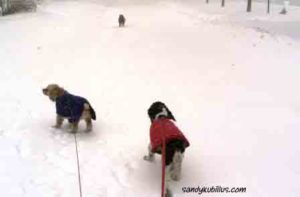We used to call it road salt or just salt. That was when the only thing available was rock salt (sodium chloride). Now, there are so many formulations, many of which say “Environmentally Friendly,” or “Safe for Pets.” But are they?
My elderly mom used to put down loads of rock salt between her back door and the garage anytime it seemed slippery. She over did it, but she needed to make sure she wouldn’t slip and break her hip. She didn’t worry too much about her two cocker spaniels (who became my dogs). Buffy and Chipper only went outside for a few minutes and then came back inside. If they licked their paws, my mom didn’t worry about it.
I’m the opposite of my mom. I walk around the block or sometimes farther, several times each day. I don’t use any salt on my driveway unless it’s very slippery, and then very little at the base of the stairs. But I have no idea what my neighbors, the park, and local businesses use on their sidewalks.
Effect on dogs
Salted sidewalks often caused my dogs to limp and refuse to walk since it burns their paws. I discussed these issues in my last blog post (4 tips for walking your dog in the snow).
Other than the irritation on their paws, dogs will often lick the salt on their pads. Usually the amount ingested is minor and not likely to cause much stomach upset. But some dogs are more sensitive or eat a lot more. 
According to the pet poison help line, problems can occur with ingesting large amounts of ice melts:
- Sodium chloride can be toxic at very high doses (4 g/kg of body weight). This is a lot, so don’t panic. Hypernatremia is an increased in the salt concentration in the blood causing dehydration. Ingesting lower amounts can lead to vomiting and diarrhea.
- Potassium, magnesium, and calcium salts can all cause gastrointestinal upset. Some may also irritate their paws and skin.
- Urea is often the main ingredient listed in pet-friendly ice melts. But it too can cause mild gastrointestinal irritation and salivation. Eating large amounts can cause weakness, tremors , and methemoglobinemia (a blood disorder)
Effect on the Environment
I work as a lakes management consultant where I test the water quality of lakes and ponds. Road salt ends up in our lakes and streams and other than dilution by the summer rains, it pretty much stays there. Normal levels that I see are around 100 ppm in the middle of summer. This is after the spring rains have diluted the winter road salt. But sometimes at depth, I will find very high concentrations of over 10,000 ppm. Salty water sinks below fresh water. Levels above 500 ppm are above the state standard for Illinois.
I monitored one small lake for over a decade. It was in an environmentally friendly subdivision. At first, they didn’t use any road salt, only sand by the stop signs. At that time, chloride levels in the lake averaged 50 ppm. When they started using road salt, the chloride concentration jumped to almost 300 ppm the next year. https://www.pchoa.com/picture/pc_lk_year_end_2005.pdf. Eventually, the community switched to using an environmentally safe alternative. Then the chloride levels in the lake started going down.
High levels of salt can degrade a lake and limit the diversity of the plants and animals that inhabit it.
What should you choose?
- Read the label. Not just to see if it is pet friendly—actually read the ingredients. If the label has a warning for children—it’s probably not safe for your pet either.
- Tip—google the name of the product and add SDS to the search. These list ingredients and the hazards to people, pets, and the environment.
- I checked the SDS sheets of several ice melts. Safe Paws lists 99% proprietary ingredients (so they don’t have to list them). The product is listed as non-hazardous. Morton Safe-T-Pet mostly consists of urea. My local park may use Purple Heat, since the pellets are purple. This one is mostly sodium chloride.
- Sodium chloride is the most hazardous, but it is the cheapest and most common ice melt. Calcium, potassium, and magnesium chlorides can also harm the environment.
- Calcium magnesium acetate (CMA) is pretty safe. But it is not very effective below 20°F, which means it doesn’t work where I live near Chicago. Often CMA is mixed with chlorides to boost its effectiveness.
- Urea (carbonyl diamide) can also be harmful to the environment. It has a lower toxicity rating than the chlorides.
- If it has a colorant, check the ingredients. Make sure these are also safe for your pet.
- Tip—google the name of the product and add SDS to the search. These list ingredients and the hazards to people, pets, and the environment.
- The cheapest ice melts are usually not safe for pets. The components to make ice melts safer also cost more and are in less demand.
- What about materials that offer better traction?
- Sand is good, if used in moderation. Light sand can blow away, so use coarser granules. Sand doesn’t disintegrate, so if you use a lot of it on your driveway and sidewalks, it will pile up at the edges. Wet sand can also make a mess in the house, leaving the floors gritty. If you use sand, take off your boots by the doorway and wipe your dog’s paws.
- Kitty litter has clay as the main ingredient. This can leave an even bigger mess in your house when it is wet. Wood ash also leaves a mess.
So none of the ice melts are 100% safe, especially if your pet eats a large quantity. The best things to do include:
- Use as little ice melt as possible and one that is the safest for your pet and the environment.
- Have your dog wear booties when walking on ice melts.
- Wash and wipe your dog’s paws when they come into the house after they have walked on salted streets or sidewalks.
- Don’t ever let your pet eat ice melt.
Please leave a comment below on your experiences with ice melts.
Also, sign up to receive my blog each week in the box at the top right—thanks.
Further reading:
https://www.petmd.com/dog/care/pet-safe-ice-melts-are-they-really-safe


I’m always careful about what we put on our walkways, making sure it’s safe for out dogs. Best thing we do is make sure we shovel early and often so melted snow doesn’t freeze.
—Wags (and purrs) from Life with Dogs and Cats
Some great information about ice melts I didn’t know. That is my life right now – Ice everywhere and we can’t wait for it to all go away! Lucky the kitties have their catio to roam in and I don’t have to use the de-icers where they go.
This is one of the things I love about living in the middle of nowhere. We don’t have to bother about such things. We strictly use sand only or mechanical removal, depending on which is most practical. Only couple times we were desperate enough to resort to salt – guess what? I decided to use Epsom salt LOL Not as effective but safe.
Getting booties on the paws is tough, but at least I always wipe the paws down. I worry about this and try to use Safe Paws on my driveway and sidewalks. I worry about wild animals and cats roaming around as well – I wish things like this could be regulated.
Great tips! I use ice melt sporadically when it’s really icy in the backyard, and I always sprinkle it right after bringing Roxy & Rico inside so it can dissipate a bit and they forget about it and aren’t tempted to lick it.
Wow, this is a great article with terrific technical information. Will book mark, and send folks over here. That’s quite concerning, re: the change in the lake testing from one year to the next. Thanks for the wake up call!
Interesting post. I don’t have a dog however this post is great. It’s someting you wouldn’t necessarily think about. Great information for pet parents. And another incentive to have your pups wear booties for their own protection.
My peeps use none of that ice meltin’ stuff in our yard on account of their believin’ it is both bad for the environment and us. The county uses sand on our road. It’s only a mess in the spring when you find the remnants at the end of the driveway after all the snow has melted. On the steps, Peep #1 sprinkles kitty litter and yes, it can be messy. “But better than fallin’!” is what she says. PURRS
What a great article! Honestly, it never occurred to me what was in the ice melts/salt, I just figured it was salt and that salt not only melted the ice, but caused havoc on my dogs paws – why she wears boots. The have started spraying a liquid on our streets prior to snow or ice storms – I can only imagine what is in it! However, the city and neighbours still place plenty of salt down on the sidewalks to prevent slips and falls.
This is great info! I’ve never thought about “ice melts” before and their safety (I live in a non-snowy area), but it makes sense that some may not be environmentally safe. I like how you point out that if it’s not safe for children, then it obviously wouldn’t be safe for pets either!
People throw all that junk onto the roads and pavements? REALLY?!?!?!?!?! That’s insane. That is destroying the environment and damaging dogs (and any cats who may tread the neighbourhood snow).
Why is is always the ‘cheap is best’ people who win out. We will lose our environment at this rate and we can’t get it back.